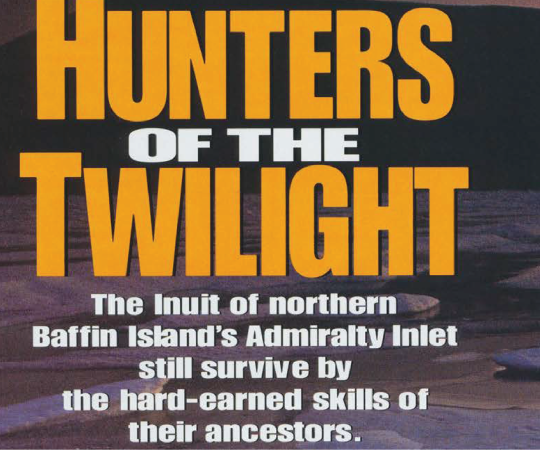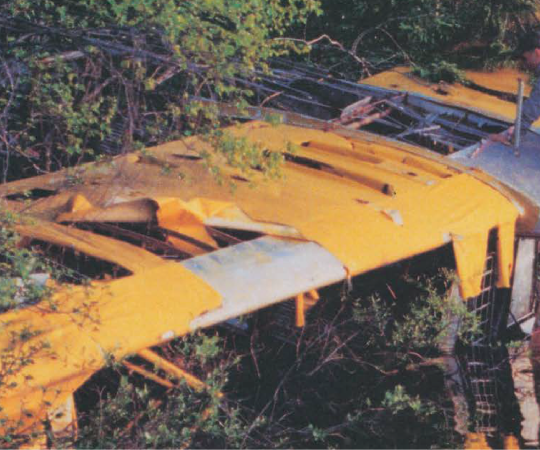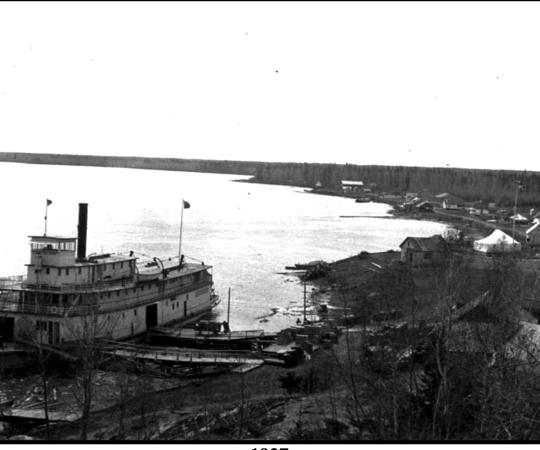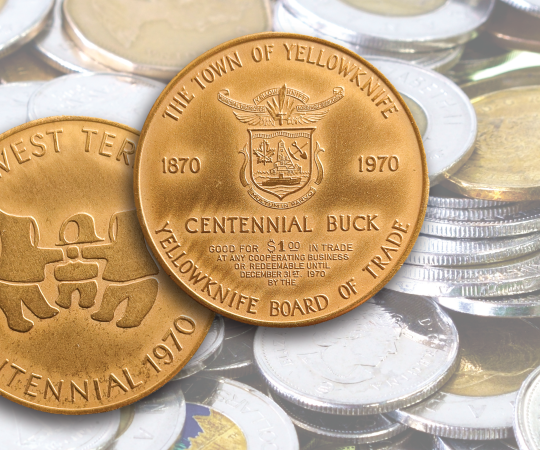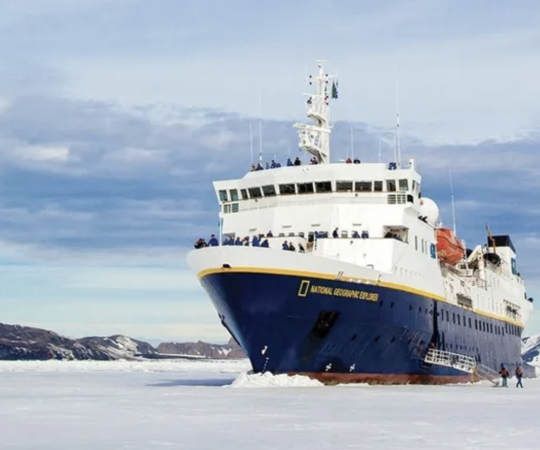It’s January and the days are starting to get longer. There’s still no sun and it won’t be seen again until mid-February; it last dipped below the horizon on October 28. But it’s not complete darkness in Grise Fiord.
“People think when the sun goes, everything suddenly turns black,” says Larry Audlaluk. During even the darkest days, “you always had twilight—just red twilight or deep-blue twilight on the horizon. But you could hardly see far,” he says. Today, the darkest days are lighter—a meteorological phenomenon Inuit hunters have noted for years, only now being acknowledged by Western science. “You can actually see much further out, more than say over 40 kilometres on some clear days.”
People have many preconceptions about Grise Fiord—Nunavut’s smallest and Canada’s most northerly community, sitting above the 76th parallel. It must always be winter there and really expensive and near impossible to get to, right? And sure, life can be tough. The long distances and short shipping windows, with year-round, twice-weekly Twin Otter service, means food prices are high—$8-plus for a can of pop sometimes. To pursue a post-secondary education, oftentimes even employment, you have to leave the community, which isn’t cheap. (It costs $1,200 for a return flight to Resolute. And that’s just the start.) The nursing station is often understaffed (though Audlaluk says the situation is stable right now, with two half-time nurses). And the town of 160 is small enough that you know everyone. “You get tired of living in a fishbowl after a while, you know?” says Audlaluk. “And sometimes, you don’t care to know your neighbours’ dirty laundry—but you can’t help it.”
Yet for all that, Audlaluk relishes Grise Fiord’s location at the nexus of some of the most important issues of the day—Arctic sovereignty, climate change, to name just a couple. “People have seen signs of submarines in Jones Sound,” he says. “Yeah, there was a periscope sighted last September and it was going against the wind. And three people saw it from three different locations in the community.”He’s not what he calls an “armchair philosopher,” a pundit seated comfortably on a sunny veranda making comments on the Arctic from the south. “I’m right where it’s at,” he says. “People say, ‘the Northwest Passage, way up on top of the world, in an inaccessible area’ … I’ve never thought like that. I’m looking down from above.”
And if people think Grise Fiord sits in complete darkness all winter long? “That’s okay for us because that means people are scared to come up during the dark season,” he says. “Great. That gives us peace and quiet.” But that doesn’t mean Audlaluk wants the world to leave Grise Fiord alone. Far from it.

LARRY AUDLALUK IS something of a historian, and his own life is interwoven with the entire history of his community. Grise Fiord and surrounding area have been his home since he was almost three years old, when he and his family boarded the patrol ship C.D. Howe with seven other families in Inukjuak, Nunavik, to head north as part of the Canadian government’s High Arctic Relocation in 1953.
This experiment’s stated intention was to have Inukjuamiut leave their economically stagnant community to live by traditional means in the Arctic. But that’s not the whole truth—or even most of it.
As Audlaluk points out, backed by government documentation and correspondence he’s spent decades poring over, the relocation was a way for Canada to assert its sovereignty in the High Arctic. Up until the 1950s, only government institutions such as the RCMP, the military, and weather stations existed that far north. There were no Canadian communities and no civilians living there year-round, which caused foreign nations to question the legitimacy of Canada’s claims to the territory.
RCMP went around Inukjuak to recruit families for the relocation earlier that spring. Inuit were told they could return home after two years. That promise was broken.
A group of families continued on to Resolute, while the rest of the families were dropped off at Craig Harbour, 55 kilometres southeast of present-day Grise Fiord. They realized immediately that the hunting equipment they were promised was inadequate. “My uncle was very adamant. He said, ‘My god, what are you doing? You’re going to get us killed. We can’t hunt walrus with just a little canoe—walrus can be very dangerous,’” says Audlaluk. They were granted occasional use of an RCMP boat, but that was quickly rescinded. Restrictions on hunting caribou and muskoxen would soon be imposed.
Less than two weeks later, they were displaced again, this time 70 kilometres west to Lindstrom Peninsula. The reasoning was heartless. An RCMP report reads: “Being encamped at Craig Harbour [near the RCMP detachment] might have given these natives the tendency to look for handouts when not absolutely necessary.”
“The first two years were just survival,” says Audlaluk. He remembers living in a tent community at the foot of the peninsula’s towering mountains.
Less than a year after the relocation, Audlaluk’s father, Akeeaktashuk, died. The once vital leader had become quiet—he confided in friends that he regretted agreeing to the move, realizing now that they wouldn’t be returning home. “He sighed a lot,” says Audlaluk. He also suffered from fainting spells.
The manner in which his father’s death was revealed to the world shows how the government distorted the truth about the relocation. Akeeaktashuk was a rising star in the carving world and his obituary ran in Time Magazine. It claimed that he’d died heroically hunting walrus with a kayak. “When I went to Iqaluit as a boy, because I had to go to the hospital … my relatives asked, ‘What happened to your father? Is it true he died while hunting walrus?’ I said, ‘No, he died of a heart-attack,’” says Audlaluk. “So you can see, the government wanted the relocation story to be a success.”
The Craig Harbour RCMP detachment was later moved to Grise Fiord and when a school was built in 1962, Inuit at Lindstrom Peninsula moved there too. Since then, Grise Fiord has become home to Audlaluk and others, with its abundance of seals, Arctic char, and caribou nearby.
But some of the institutions that abandoned Inuit there 65 years ago have floated the idea of closing Grise Fiord due to the very isolation that prompted its creation. “We’ve always had to fight for our existence,” he says.
Due to its short runway, with a curved approach near high mountains—often navigated in darkness—Grise Fiord is one of the most difficult towns to access in all of Canada. In the 1970s, the NWT government seriously considered shutting down the community because planes were having a hard time making it in and the nursing station was seen as too costly to operate. “That really scared people and that really put us together,” says Audlaluk.
More recently, in 2014, an MLA stood up in the legislature and asked if keeping open Grise Fiord—and a few other small Nunavut communities—was worth the expense. “It was almost like testing the Government of Nunavut and how they felt,” says Audlaluk. “Very fortunately, even the premier and other MLAs said, ‘We cannot close Grise Fiord. It’s too important.’”
AUDLALUK INVITES ME to visit him. I can’t miss his place, he says: “You can find my house because I have a Canadian flag flying.”
Despite Canada’s ignominious record with Inuit, with Audlaluk’s own family, he still flies the flag. I’m taken aback by his capacity to forgive. We say goodbye, but a week later, I call him back because there’s a question I need to ask. How is he able to do that after all that Canada has done to him?
“I just couldn’t go around living all my life being bitter and angry.” He admits he harboured resentment about the relocation, about how Inukjuamiut and Pond Inlet people were moved with nothing. “I was a very angry person for a long time,” he says. “In fact, I became an alcoholic because of it.”
“If the relocation was to be done properly, Inuit would have been asked,” he says. But the group pitching the idea was all qallunaat—white people. “Remember, this is the 1950s, when the colonial attitude was still very strong.”
Part of what helped Audlaluk work through his anger and overcome his drinking was his commitment to learning about the relocation and the real motivations behind it. When we first talked, he told me the relocation story from both the government side and from the Inuit perspective, each with historical context and detailed background. Audlaluk was one of the more prominent voices calling on Ottawa to acknowledge and apologize for its actions. “And they gave us a small token of reconciliation, but it still comes short. We have not been able to go see our families when we want to. We were not given any kind of compensation for the airline. Cost of living is still extraordinarily high,” he says.
Since Grise Fiord’s inception, Audlaluk has noticed the subtle difference in the way government employees are treated versus local Inuit. Transient southerners are lured to Grise Fiord with big paycheques and generous living, food, isolation and travel allowances. “They have everything looked after,” he says. And many are often good people, and make contributions to the community, they generally leave after a few months or years to retire to the south. The civilian population, the people who remain, the people who grow old in Grise Fiord, are not entitled to all these subsidies, to the comfortable lives others choose in the south. (Grise Fiord has no arena; when a large, inflatable pool was set up in a school gym last summer, it made the news.)
Audlaluk is proud of what he and Grise Fiord do to assert Canadian sovereignty in the High Arctic. Ten years ago, Florin Fodor, a Romanian who’d been deported from Canada, pulled his beleaguered boat onto Grise Fiord’s shores after an eight-day trip from Greenland that left him hungry and with just five litres of fuel. (He planned to circumvent customs and continue on to Toronto to reunite with his family.) The town took notice. “A lot of people think the North is empty, there’s nobody up here, nobody is watching us. That was his mistake. When you have a small place like Grise Fiord, everybody knows who’s doing what, what they had for breakfast. Everybody does,” he says. “And we were able to find out what’s wrong instantly.”
“We are the wards. We’re the guardians for the government,” he says. “We pay taxes and this is our home.” But it’s frustrating to continue to do this job, he says, when it feels like long-time residents of Grise Fiord—the people who continue to perform that important task for Canada—are forgotten.
Audlaluk is savvy—a political animal. When asked what he does for a living, instead of saying he’s the town’s economic development officer, he’ll sometimes switch it up: “I like to think I’m an unofficial lobbyist for Grise Fiord and sovereignty of the high Arctic.” He recognizes the strategic importance of Grise Fiord’s location and he plays up the role of human flag-bearer to the community’s advantage—as a way to lobby the feds for help, to make their lives more comfortable.
And it works. He recently had a private audience with Prime Minister Justin Trudeau, where he pressed him about ownership of the Northwest Passage. “I’m one of the people who is scared to death if the Northwest Passage ever gets opened up to the world,” he says, emphasizing the potential for environmental damage from accidents due to increased traffic. Trudeau assured him that he’ll continue to assert Canada’s claims to the passage, but Audlaluk wants to know who would benefit from it opening up. “Are we going to be left out again?”
Not everyone in town shares his passion for politics or his patriotism. And though he’s served in a multitude of political positions—some regional, some local—he’s now encouraged by the younger generation of leaders in Grise Fiord. His daughter, for one, has been the town’s deputy mayor, on and off.
It can be hard to make the world pay attention to Grise Fiord, so far away from southern power centres. Some evenings, Audlaluk will watch the news with interest, learning about the latest moves by Russia in the Arctic or the newest global warming warning. He’ll look out at the darkness, out the window of his home flying the Canadian flag on the shores of Jones Sound, with no other human settlement for hundreds of kilometres in any direction, right in the middle of it all. And he’ll say to himself, “I’m still here, you bastards.”



